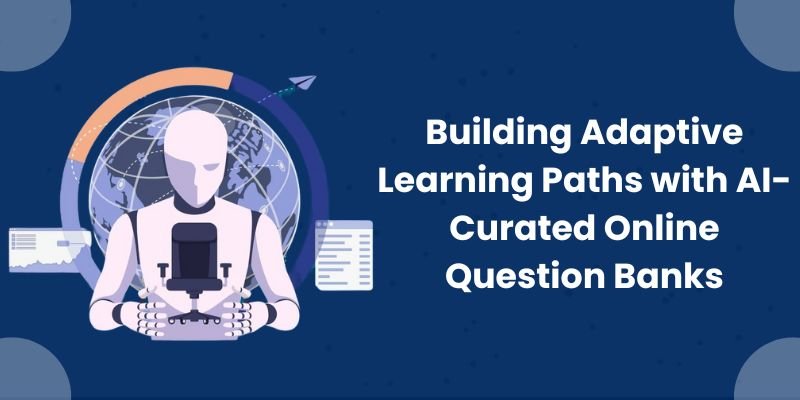In today’s education landscape, personalization is no longer a luxury—it’s a necessity. The traditional, one-size-fits-all model of learning has proven inadequate for addressing the diverse needs of modern students. As educational institutions pivot towards digital-first strategies, one key innovation is taking center stage: AI-curated online question banks that help build adaptive learning paths.
This blog explores how AI-powered question banks are transforming education, improving student outcomes, and making learning more personalized, scalable, and efficient.
The Shift Toward Adaptive Learning
Why Traditional Methods Fall Short
Traditional teaching methods tend to generalize content, failing to account for individual learning speeds, prior knowledge, and skill gaps. This results in students either falling behind or becoming disengaged due to a lack of challenge. The rigid nature of conventional assessments also limits teachers’ ability to identify and address specific learning needs.
The Rise of Adaptive Learning Technologies
Adaptive learning leverages artificial intelligence and data analytics to tailor content and assessments based on a learner’s performance and progress. By analyzing how students interact with content and questions, the system can dynamically adjust the difficulty level, revisit weak areas, and reinforce concepts through personalized recommendations.
The Role of AI-Curated Online Question Banks
What Are AI-Curated Question Banks?
AI-curated question banks are dynamic repositories of assessment content that are continuously updated and optimized through machine learning algorithms. These platforms analyze student behavior and performance data to serve up the most relevant, level-appropriate questions for each learner.
Features That Power Adaptive Learning
- Smart Tagging: Questions are categorized by topic, skill level, and learning objectives.
- Real-Time Feedback: Immediate feedback helps students learn from mistakes.
- Content Diversity: Includes multiple formats like MCQs, short answers, coding challenges, and scenario-based questions.
- Performance Tracking: Dashboards allow teachers and students to monitor progress over time.
- Difficulty Adjustment: Algorithms adjust question complexity based on learner proficiency.
Benefits of AI-Driven Adaptive Learning Paths
1. Personalized Learning Experience
Each student receives a unique path that adapts to their learning pace, style, and strengths. This level of personalization enhances engagement, retention, and academic performance.
2. Scalable for Institutions
Adaptive systems can cater to thousands of students simultaneously, making personalized education scalable for universities, schools, and online learning platforms.
3. Data-Driven Decision Making
Institutions can use learning analytics to make informed decisions about curriculum design, teaching strategies, and resource allocation.
4. Efficient Remediation
Students who struggle with specific topics receive targeted practice and additional resources. This ensures no learner is left behind.
5. Encourages Active Learning
Instead of passively consuming content, students are actively engaged in problem-solving and reflection, reinforcing long-term retention.
Implementation in Academic Settings
Integrating with LMS
AI-curated question banks can be integrated with Learning Management Systems (LMS) to provide seamless access within a student’s learning environment. This integration ensures a unified platform for instruction, assessment, and feedback.
Supporting Blended and Online Learning
These tools are ideal for hybrid learning models. Whether students are on campus or learning remotely, they benefit from real-time feedback and personalized learning paths.
Use Cases Across Disciplines
From STEM subjects to language learning and business studies, adaptive question banks can support a wide range of academic disciplines. They help students master concepts through practice, analysis, and adaptive feedback loops.
Technology Behind the Scenes
Machine Learning Algorithms
AI engines use supervised and unsupervised learning techniques to analyze patterns in student responses. These patterns are used to predict future performance and recommend optimal learning paths.
Natural Language Processing (NLP)
NLP enables the system to generate and understand open-ended responses, making feedback more intuitive and personalized.
Predictive Analytics
Advanced analytics identify at-risk students before they fall behind, allowing educators to intervene proactively.
Challenges and Considerations
Data Privacy and Ethics
Institutions must ensure that student data is stored and processed securely, adhering to privacy regulations like GDPR and FERPA.
Content Quality
The effectiveness of AI-curated question banks depends heavily on the quality of the question pool. Regular updates and expert reviews are essential.
Teacher Training
Educators need adequate training to interpret analytics and effectively incorporate adaptive tools into their teaching strategies.
Measuring Success
Key Performance Indicators
- Improved Test Scores: Track how adaptive learning correlates with student performance.
- Engagement Metrics: Monitor time spent on tasks, completion rates, and participation.
- Feedback Loops: Analyze how well students respond to feedback and adjust their strategies.
The Future of AI in Learning Assessment
Intelligent Tutoring Systems
We can expect AI to evolve into full-fledged tutors, offering hints, explanations, and encouragement just like a human educator.
Cross-Platform Integration
AI-driven systems will be integrated with everything from mobile apps to virtual labs, enabling learning anytime, anywhere.
Gamified Assessments
To boost engagement, future question banks may incorporate gamification features like badges, streaks, and real-time leaderboards.
Multilingual and Inclusive Learning
AI will facilitate multilingual support and accessibility features for students with diverse backgrounds and learning needs.
AI-curated online question banks are not just a technological upgrade—they represent a paradigm shift in how we understand, deliver, and assess education. By creating adaptive learning paths, these tools ensure that every student gets a tailored, engaging, and effective learning experience.
As educational institutions continue to innovate, embracing adaptive learning technologies will be key to staying relevant, improving outcomes, and preparing students for a rapidly evolving world.












